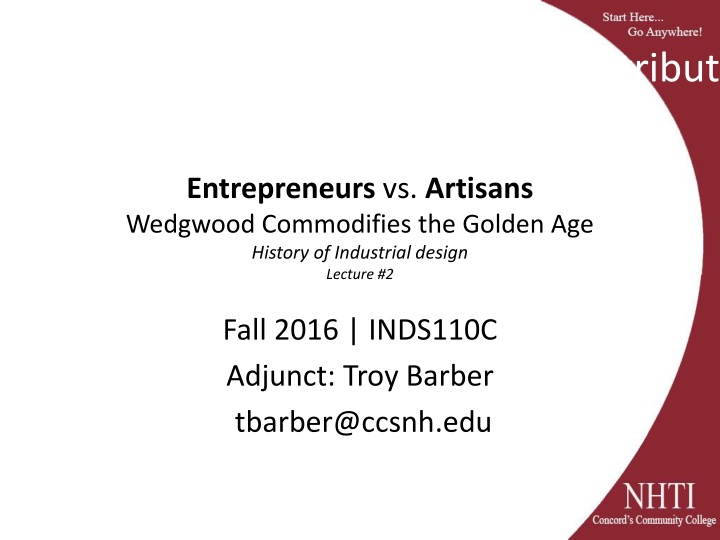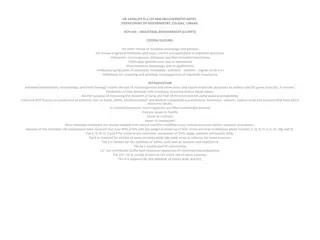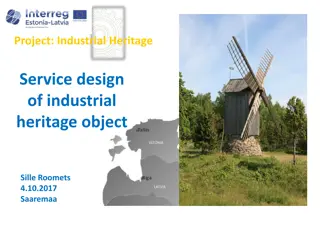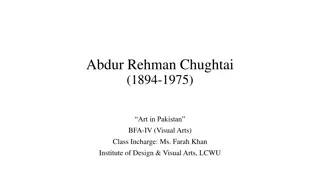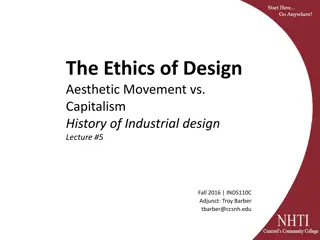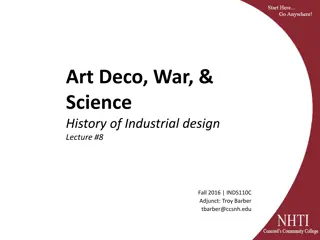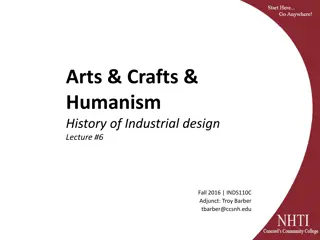Influence of Art Movements on Industrial Design History
Baroque, Rococo, and Neoclassicism are art movements that have significantly influenced industrial design history. Baroque is characterized by exaggerated motion and drama, Rococo by playful and ornate designs, and Neoclassicism by simplicity and symmetry. These movements reflect societal trends and aesthetics, shaping the development of design during their respective time periods. The Industrial Revolution further revolutionized manufacturing processes, leading to significant advancements in design and production.
Download Presentation

Please find below an Image/Link to download the presentation.
The content on the website is provided AS IS for your information and personal use only. It may not be sold, licensed, or shared on other websites without obtaining consent from the author.If you encounter any issues during the download, it is possible that the publisher has removed the file from their server.
You are allowed to download the files provided on this website for personal or commercial use, subject to the condition that they are used lawfully. All files are the property of their respective owners.
The content on the website is provided AS IS for your information and personal use only. It may not be sold, licensed, or shared on other websites without obtaining consent from the author.
E N D
Presentation Transcript
NHTI information and Attribution Entrepreneurs vs. Artisans Wedgwood Commodifies the Golden Age History of Industrial design Lecture #2 Fall 2016 | INDS110C Adjunct: Troy Barber tbarber@ccsnh.edu
Art Movements Influencing ID History: Baroque Baroque (1600 1730): Exaggerated motion and clear, easily interpreted detail to produce drama, tension, exuberance, and grandeur. Trade with China fosters a desire for porcelains and lacquer work. Gold and silver framework often surround precious porcelain.
Art Movements Influencing ID History: Rococo Rococo (1720 1780): Used a more jocular, florid, and graceful approach to Baroque. Style was ornate and used lightcolors, asymmetrical designs, curves, and gold. Unlike Baroque which was promoted by the Church Rococo had playful and witty themes. Rococo rooms were designed as integrated works of art with elegant and ornate furniture, small sculptures, ornamental mirrors, and tapestry complementing architecture, reliefs, and wall paintings. Pair of lovers group of Nymphenburg porcelain, c. 1760 Niderviller porcelain, 1761 66, Rococo, France
Art Movements Influencing ID History: Neoclassicism Neoclassicism (1750 1830): Neoclassical design is based on the principles of simplicity and symmetry, which were seen as virtues of the arts of Rome, Ancient Greece,andthe Near and Far East. Utilizes some models among the range of possible classics that are available to it, and ignores others. Empire style sauce boat, S vres Porcelain, c. 1809 10 Wedgwood vase in the style of Greek red-figure pottery, c. 1815 Empire style table Grand Neoclassical interior by Robert Adam, Syon House, London
Neoclassicism: Why look to the past? Why then? Industrial Revolution: Transition to new manufacturing processes in England from about 1760 to 1820-1840. This transition included: Machines replaced Hand production methods New chemical manufacturing and iron production processes Improved efficiency of water power and steam power Rise of the factory system Textiles were the dominant industry in terms of employment, value of output, and capital invested The Industrial Revolution began in Great Britain and most of the important technological innovations were British.
Industrial Revolution: Powering Up Water Power: Abundant energy, but water-driven machines needed to be located close to rivers. Steam power : Efficiency of steam engines increased throughout the industrial revolution. Adaptation of stationary steam engines to rotary motion made them suitable for industrial uses. Steam power underwent a rapid expansion after 1800, meaning factories could be located virtually anywhere.
Industrial Revolution: Textiles Textiles: Mechanized cotton spinning powered by steam or water dramatically increased manufacturing output. The power loom mechanized the process of weaving cloth The cotton gin also dramatically increased productivity of removing seed from cotton. Spinning and weaving of wool and linen also saw significant gains, but they were not as great as in cotton.
Industrial Revolution: Pumping Iron Iron making : Substitution of coke for charcoal derived from wood greatly lowered the fuel cost for pig iron and wrought iron production Using coke also allowed larger blast furnaces, resulting in economies of scale. Britain had plentiful coal close to the surface; the need to remove water from mines drove innovation of the steam engine. More coal = more steam engines = even more coal
Neoclassicism & Wedgwood: Selling a Golden Age Josiah Wedgwood (1730-1795) Smallpox permanently weakened one knee, making him unable to work the foot pedal of a potter's wheel. Concentrated on designing pottery and allowing other potters to execute his designs. Came from family of potters in Staffordshire, England. Initial innovations were focused on innovative glazes. Cream-colored glazed earthenware. Simple, regular shapes.
Wedgwood Queens Ware Service Pottery Wedgwood pottery competed with the most costly luxury goods from Sevres and Meissen In 1763, Wedgwood received an order from England s Queen Charlotte alongside other members of the aristocracy He convinced the Queen to let him name the service Queen s Ware
Wedgwood Pottery Innovations Continued to expand production by enlarging production facilities. Used molds instead of potters wheels. Developed a transfer method of applying decorative borders to replace hand-painting. Saved time, ensured uniformity, gave customers a wide variety of design choices within a limited range of shapes and decorative patterns. Thomas Jefferson the 3rd President of the United States (1801-1809) purchased a Wedgwood cremeware service set although he also purchased a Sevres dinner service after visiting France in 1784-1789.
Wedgwood Pottery Antecedents Mimicking the Portland Vase, c. 1-25 AD First mentioned in Rome in 1600-1601, and brought to the British Museum in London in 1810. Industrial Revolution was a time of great change and the Portland Vase embodied a recollection of a Greco-Roman Golden Age. This period also saw the rediscovery of ancient sites of Pompeii and Herculaneum which only fired public interest.
Wedgwood Pottery Basalt & Jasper Ware Basalt (black) and Jasper (blue) opaque pottery
Josiah Wedgwood - Legacy Credited as the inventor of: Direct mail Money back guarantees Travelling salesmen Self-service Free delivery Buy one get one free Illustrated catalogs Invested in construction of canals to control transport, supply, and delivery
Neoclassicism Hits the Bigtime Thomas Chippendale Thomas Chippendale (1718-1779) London cabinet maker and furniture designer in the mid-Georgian, English Rococo, and Neoclassical styles. Published The Gentleman and Cabinet Maker's Director (1754), a catalog of furniture designs that wealthy urbanites could fill their homes and apartments with. First printing purposefully coincided with the opening of Parliament after a general election, e.g. new members would be moving to London and needed furniture!
Other Styles: Thomas Johnsons Candelabra Thomas Johnson (1714-1778) Primarily designed outlandish picture frames and candelabras
Summarizing the Industrial Revolution in Britain Time of great changes in materials, processes, and division of labor. Unlike France, the British crown and state played a less intrusive role in defining acceptable aesthetics and supporting particular industries. Most technological breakthroughs were being paid for by Capitalists / wealthy benefactors. This ultra-competitive environment rewarded innovation and efficiency. It also rewarded companies that could market themselves effectively. Neoclassic design predominated but a wide variety of other tastes were available to an expanding consumer class.
Grant Information Get IT is sponsored by a $2.5 million grant from the U.S. Department of Labor, Employment & Training Administration TAACCCT Grant #TC-26498-14-60-A-33 NHTI, Concord s Community College, is an equal opportunity employer, and adaptive equipment is available upon request to persons with disabilities. This workforce solution was funded by a grant awarded by the U.S. Department of Labor s Employment and Training Administration. The solution was created by the grantee and does not necessarily reflect the official position of the U.S. Department of Labor. The Department of Labor makes no guarantees, warranties, or assurances of any kind, express or implied, with respect to such information, including any information on linked sites, and including, but not limited to accuracy of the information or its completeness, timeliness, usefulness, adequacy, continued availability or ownership.
NHTI information and Attribution NHTI, Concord s Community College 31 College Drive Concord, NH 03301 www.nhti.edu INDS110C Industrial Design History Curriculum by Troy Barber is licensed under the Creative Commons Attribution 4.0 International License. http://creativecommons.org/licenses/by/4.0/deed.en_US To view a copy of this license visit http://creativecommons.org/licenses/by/4.0/deed.en_US.
